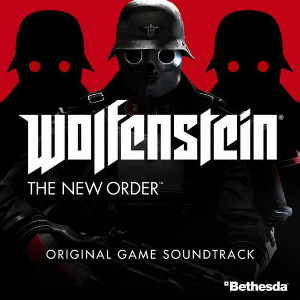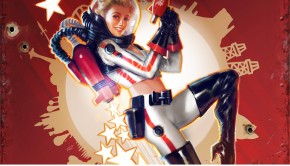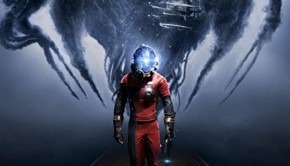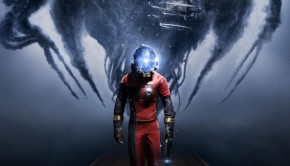Wolfenstein -The New Order- Original Soundtrack
 |
Album Title: Wolfenstein -The New Order- Original Soundtrack |
| Record Label: Bethesda Softworks |
|
| Catalog No.: N/A |
|
| Release Date: May 19, 2014 |
|
| Purchase: Download at iTunes |
Overview
Mick Gordon was continuing his retro-game streak when he signed on to compose for Wolfenstein: The New Order, a game that continues the Wolfenstein series first released in 1981 with Castle Wolfenstein. The series has had a huge influence on the popularity of the first-person shooter genre, and has not hesitated to take risks. Most recently, Wolfenstein: The New Order is written in an alternate historical world, in which Germany and the other Axis powers defeated the Allied Powers at the end of the Second World War. Gordon’s approach to the soundtrack is as unique as the game itself; he created a very different sound from the average soundtracks with his combination of noisescapes, electronics, and guitar to create a strange, distorted soundtrack to match the strange, distorted world of Wolfenstein.
Body
Perhaps the most immediate feature of the album is Gordon’s use of guitar. The album consists of a plethora of varying guitars and guitar techniques blended heavily with electronics and static-filled soundscapes. The alternative nature of the soundtrack, beginning with the hair-raising “Deathshead,” reflects the distorted reality of the game, which includes hazy skies, urban desolation, and the swastika draped prominently over the remaining buildings of the game. The following track, “Adrift,” brings an acoustic guitar into the soundtrack, letting the listener know early on that our universe is not completely lost; “Adrift” riffs through a series of broken triads in a tranquilizing, simultaneously serene and ominous, piece.
By the next track, however, the tranquility is gone. “The New Order” is one of the most popular tracks of the album, featuring descending series of heavy metal chords. The piece is oddly beautiful, and it is surprisingly the most peaceful track up to this point, if not of the whole album. The chords are familiar and soothing, and the heaviness, per se, backs off halfway through the piece to allow for a more gentle hard rock guitar solo. Those electronic guitar solos continue to be interspersed throughout the album in tracks like “Konzentrationslager” and “Zellenblock B-2,” both of which feature a concurrent electronics and electric guitar solos.
The album as a whole is, consequently, an appropriately jarring one. Not just because of the individual tracks, but because of how the tracks are brought together. The binding motifs are not melodic, or even harmonic, but instrumental; the wide array of guitars binds the album together, balanced with the electronics, constitutes the theme of the album. The unconventional nature of this soundtrack does a wonderful job of setting the tone of the game. “Kill Everyone” brings the album’s elements together into one piece, taking the low, static sounds from “Deathshead” and setting them to a rhythmic pulse, giving them a body that they did not previously have. And, in fact, “Frau Engel” disposes of the guitars entirely and instead brings in an ambient mix of electronics and orchestra in a gratingly dissonant series of sounds. “Der Monde” employs an unique combination of electronics and acoustic guitar, ensuring that no single element of Wolfenstein’s score is left untouched, without being combined into some other element of the music.
Gordon brings in more acoustic guitar to continue the pattern of varying guitar styles in the soundtrack. “14 Years” utilizes acoustic-funk style, occasionally running into electronic distortion and discord, assuring the listener that despite the moments of serenity, the world of Wolfenstein is still exceptionally dark. “The Kreisau Circle” brings Wolfenstein into a more mellow light, even incorporating light, acoustic drums and finger snaps to give the song a more casual air. The final track, “Ende,” brings a thoughtful, almost soulful, mood to the album, incorporating several types of guitar and ambient sounds into the track, which ultimately falls into a borderline genre just between ambience and musical structure. Eventually it ends with a pulsing acoustic pattern underlying a gentle electric guitar melody.
Note that the licensed songs for the game, most of them German parodies of 1960s pop hits, are omitted from this instrumental soundtrack. These songs are available exclusively as a limited edition vinyl through Bethesda’s online store. They’re a select taste, but will appeal to some listeners.
Summary
In scoring Wolfenstein, Mick Gordon set out to create a musical setting that would fit the alternate 60’s universe depicted in the game. The score is extraordinarily fun, and Gordon’s compositional methods, aiming for the unusual and the unique, serve as a successful companion to the Wolfenstein, both in-game and out-of-game. While some of the static tracks might blend together after listening straight through the album, the constantly shifting guitar sounds bring different flavors to the game through odd and exciting bursts of color that keep the music moving. Available for 10 USD from digital retailers, this soundtrack is well worth your time.
Do you agree with the review and score? Let us know in the comments below!
4
Posted on November 17, 2014 by Emily McMillan. Last modified on November 16, 2014.














